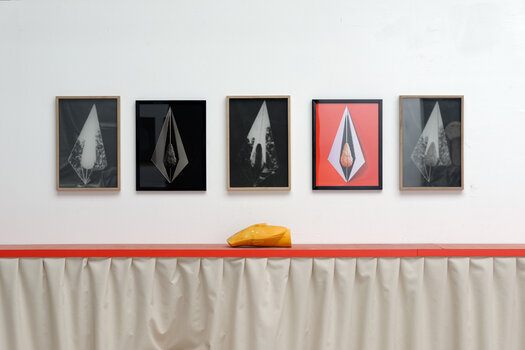Bénin
Solo Show !At Passerelle
41, rue Charles Berthelot
F – 29200 Brest
from 09.26.2015 – 01.02.2016
opening 09.25.2015, 18:00
Aurélien Mole cultivates a dandy artist approach, combining sophistication precision and poetic of the making.
His work plays with insight and awareness of both historical and artistic references. His project for Passerelle Centre d’art co,temporain mischievously entitled “Benin” – somewhere between nonchalance and exoticism – deals with history of art and technology especially photographic, as objects of study as well as creation supports.
In the center of the whole project, a film draws inspiration from Hippolyte Bayard’s researches. He was a photographer, an inventor and an employee of the French Ministry of Finance at the end of the 19th century. Bayard used to spend his lunch breaks on the rooftop of the administration where he dispayed plaster statuettes on a black backdrop facing a camera obscura, to obtain images silhouetted in white on a black paper he invented. As often with Bayard’s works, the artistic part takes over the reserch one. The plaster statuettes, originally chosen for their whiteness, are multiplying in increasingly baroque compositions. In the end, that images Bayard records form a kind of plaster curiosity cabinet whose purpose is only distantly its two-dimensional rendering. The film is build on these compositions that provide a kind of universal museum reduced to its simplest expression. It’s a time-lapse presenting nine sunlit objects which are also presented in the exhibition.
Pursuing Bayard’s experiments, Aurélien Mole studies and plays with the conditions of appearance of things, with their tangibility in representation and production. The exhibition deals with a modern contemporary. Modern in auscultating processes of representation and making of objects (serial logic, issues of copy and original, facsimile, delegation of the artist’s gesture, craft movement today, etc). Contemporary in using today’s techniques and tools like 3D printers or decoy strategies and fantasy facilitated by viral dissemination of images on the web.
The display pursues the same referenced and critical logic. Aurélien Mole deliberately chooses to invest Le Quai. This space is emblematic of a contemporary art venue proudly bearing the scars of the building’s industrial past as a counterpoint to the sacrosanct white cube’s neutralization. The artist obstructs the space with an imposing stage curtain and installs a museum scenography which plays with theater, visual retraction and modern hanging universes. The presentation shelves that level the space in a modern perspective, both elegant and relentless, refer to the famous New York gallery 291. Founded by Alfred Stieglitz and Edward Steichen at the dawn of the twentieth century, the gallery was presenting the pioneering works of the great European masters – Matisse, Rodin, Brancusi and Duchamp – as well as ethnic and archaeological sights. This was also one of the first space of artistic recognition of photography.
“Benin” gathers many obsessions of this artist recognized as much for his artistic work, as for his assiduous observation of most exhibitions in France – Aurélien Mole is the official photographer of many art institutions – and his curatorial practice.
La scénographie mise en place poursuit cette logique citationnelle et critique. L’artiste choisit à dessein d’investir le Quai, espace emblématique d’un lieu désormais dévolu à l’art contemporain et qui porte les stigmates de son passé industriel; le bâtiment se dresse désormais fièrement à l’encontre du sacrosaint cube blanc. Aurélien Mole l’obstrue en façade par un imposant rideau de scène pour y apposer une scénographie muséale amalgamant l’univers du théâtre, des dispositifs d’escamotage visuel et des codes de l’accrochage moderne. Les tablettes de présentation qui viennent niveler l’espace dans une perspective toute moderne, à la fois élégante et implacable, font référence à l’illustre galerie 291 de New York. Fondée par Alfred Stieglitz et Edward Steichen, de grands maîtres européens se côtoyaient dans la première moitié du vingtième siècle. Outre Matisse, Rodin, Brancusi ou Duchamp, pour ne citer qu’eux, des curiosités archéologiques et ethnologiques étaient également présentées. La galerie 291 fut aussi reconnue pour être l’un des premiers lieux de reconnaissance artistique de la photographie. L’exposition Bénin que présente Aurélien Mole synthétise ses préoccupations pour une histoire de la construction des formes et des images, construction qui se veut aussi individuelle qu’institutionnelle, ce qui ne peut que mettre en relief les pratiques curatoriales de l’artiste.
---pdf de l'exposition :















